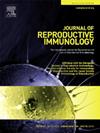中度/重度支气管肺发育不良的危险因素:一项回顾性队列研究,包括子宫内微生物准确评估的结果
IF 2.9
3区 医学
Q3 IMMUNOLOGY
引用次数: 0
摘要
我们大学开发的一种高灵敏度PCR方法可以准确地识别子宫内(IU)微生物的存在或不存在,而不会出现假阳性结果。纳入IU微生物的准确评估结果后,对107例自发性早产新生儿进行了中度/重度支气管肺发育不良(BPD)发展的危险因素检查,BPD是一种慢性肺部疾病,影响需要长时间氧气治疗或医疗通气的早产儿。比较中度/重度BPD (N = 49)和轻度/非BPD (N = 58)的围产儿危险因素。没有单独的IU脲原体/支原体感染病例。IU共感染定义为脲原体/支原体和其他细菌(脲原体/支原体以外的细菌)的混合感染(54.0% %),组织学绒毛膜羊膜炎≥II (Blanc分类),显示母体炎症反应,中性粒细胞炎症深入绒毛膜和/或羊膜(69.4% %),分娩周数[26(22 - 32)周],男性(65.3% %)中/重度BPD患者与轻度/非BPD患者有显著差异[16.7 %,46.5 %,28日(23−32)周,分别和44.8 %](p & lt; 0.01,p = 0.01,p & lt; 0.01,p = 0.03,分别)。5.4 IU合并感染(比值比(或),95 %可信区间(CI) 1.7 - 17.0, p & lt; 0.01],新生儿不成熟(或4.8,95 %可信区间1.6 - 14.3,p & lt; 0.01),和男性性(或3.3,95 %可信区间1.1 - 9.8,p = 0.03)被确定为独立危险因素的发展中度/重度桶。IU合并感染,如脲支原体/支原体和其他细菌,与中度/重度BPD的发展有关。本文章由计算机程序翻译,如有差异,请以英文原文为准。
Risk factors for moderate/severe bronchopulmonary dysplasia: A retrospective cohort study including results of an accurate assessment of intra-uterine microbes
A highly sensitive PCR method developed in our university accurately identifies the presence or absence of intra-uterine (IU) microbes without false positive results. With the inclusion of the results of an accurate assessment of IU microbes, risk factors for the development of moderate/severe bronchopulmonary dysplasia (BPD), a chronic lung disease that affects premature infants who require prolonged oxygen therapy or medical ventilation, were examined in 107 spontaneous preterm neonates. Perinatal risk factors were compared between cases of moderate/severe BPD (N = 49) and mild/non-BPD (N = 58). There were no cases of IU Ureaplasma/Mycoplasma infection alone. IU coinfections defined as mixed infections of Ureaplasma/Mycoplasma and other bacteria (bacteria other than Ureaplasma/Mycoplasma) (54.0 %), histological chorioamnionitis ≥II using Blanc’s classification showing a maternal inflammatory response with neutrophil inflammation extending deeper into the chorion and/or amnion (69.4 %), delivery weeks [26 (22 – 32) weeks], and male sex (65.3 %) in moderate/severe BPD cases significantly differed from those in mild/non-BPD cases [16.7 %, 46.5 %, 28 (23−32) weeks, and 44.8 %, respectively] (p < 0.01, p = 0.01, p < 0.01, and p = 0.03, respectively). IU coinfections [odds ratio (OR) 5.4, 95 % confidence interval (CI) 1.7 – 17.0, p < 0.01], neonatal immaturity (OR 4.8, 95 % CI 1.6 – 14.3, p < 0.01), and male sex (OR 3.3, 95 % CI 1.1 – 9.8, p = 0.03) were identified as independent risk factors for the development of moderate/severe BPD. IU coinfections, such as Ureaplasma/Mycoplasma and other bacteria, were associated with the development of moderate/severe BPD.
求助全文
通过发布文献求助,成功后即可免费获取论文全文。
去求助
来源期刊
CiteScore
6.30
自引率
5.90%
发文量
162
审稿时长
10.6 weeks
期刊介绍:
Affiliated with the European Society of Reproductive Immunology and with the International Society for Immunology of Reproduction
The aim of the Journal of Reproductive Immunology is to provide the critical forum for the dissemination of results from high quality research in all aspects of experimental, animal and clinical reproductive immunobiology.
This encompasses normal and pathological processes of:
* Male and Female Reproductive Tracts
* Gametogenesis and Embryogenesis
* Implantation and Placental Development
* Gestation and Parturition
* Mammary Gland and Lactation.

 求助内容:
求助内容: 应助结果提醒方式:
应助结果提醒方式:


